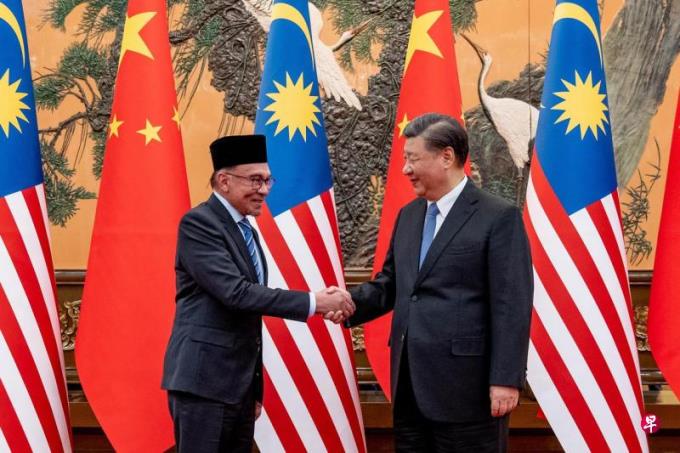
This year marks the 50th anniversary of the formal diplomatic relations in Malaysia and China.During the peak of the Cold War of the East and West in 1974, both China and Malaysia bravely across the ideological gap and established diplomatic relations.Half a century passed, and the relationship between the two countries blossomed, especially in economic and trade exchanges.China is the largest trading partner of Malaysia, and Malaysia is often the largest trading partner of China in Southeast Asia.
All circles of Malaysia are generally actively viewing the concept of China's proposal to build the Belt and Road Initiative. It is also expected that China will play the role of leading sheep in this regard. I hope that the new maritime Silk Road is based on commercial trade as the main axis to promote mutual benefit between the two parties.
For the Belt and Road Initiative, I try to think from different levels and perspectives, and try to review the implementation of the initiative from time to time.As a large country in the region, China has such a huge vision and plan, of course, has its own claims and purposes.However, Southeast Asian countries, including Malaysia, naturally have their own ideas and calculations when they respond to the large project of the Belt and Road.
Southeast Asia is located in East and West Transportation, business, trade, etc. have always been the main axis of people's livelihoods in the region. Any concept of ensuring business safety and expanding business space is widely welcomed by countries.Therefore, in order to impress Southeast Asia's heart, it must start with providing a more complete security guarantee and expanding wider business opportunities.In this regard, if the major powers of the East and the West can put their minds in the taste that best cater to Southeast Asia, the world peace and regional prosperity will be more promoted.
Some Southeast Asian countries, including Malaysia, have always taken trade as the main axis of economic development.For these countries, the biggest significance of the Belt and Road is not so complicated, but it is to deepen and expand trade with countries along the Belt and Road countries.The development of more new goods or services is the true meaning of the Belt and Road Initiative for these trading countries.
The coverage of "One Road" is far from South Asia, the Middle East and even eastern Africa.There are many countries in Southeast Asia, such as Malaysia, Singapore, etc., which not only have a multicultural society, but to a large extent, more familiar with Muslim and South Asian culture.Therefore, these countries, as the "super transit stations" of the Belt and Road Initiative, coordinate and bring in China and these "one roads" countries with more proper economies in terms of economy and other areas.
To truly make the vision of the Belt and Road Initiative successful, people's communication along the way, especially frequent contact between small and medium -sized enterprises, is essential.With people from all over the country, especially private enterprises, dare to take the first step, the vitality of the Belt and Road Initiative will be more vigorous, and it will achieve a more practical community of destiny.
But when actively promoting the new Silk Road at sea, it is extremely important to adapt to local conditions.Many countries in Southeast Asia are lagging behind. In many cases, when developing infrastructure, they have to jump into the relatively backward science and technology stage, and directly jump into the latest, highest, and best technological stage temptation.But this clever development may not be suitable for all infrastructure areas.
For example, in many parts of Southeast Asia, there are indeed a perfect railway network to transport various products more effectively and release greater economic vitality.But many times, these countries really need very basic, low -speed railway transportation, and may not be the most advanced high -speed rail services.Between the two important Southeast Asian business centers in Singapore and Kuala Lumpur, there is indeed the need to build a high -speed rail to benefit businessmen and professionals. After completion, it will also bring higher added value.But on the Borneo Island, the real economic benefits of the construction of the high -speed rail are wise.Even if the high -speed rail is built in these areas, whether it can operate for a long time remains to be considered and discussed.
Also, when promoting projects developed by the countries along the Belt and Road, the relevant parties must be more patient and do not have to be overwhelmed.Some of the style of promoting at high speeds and even building any projects are better for a long time for many South Asian countries that are accustomed to doing things.
In summary, the Belt and Road Initiative, the long -term initiative of the Belt and Road Initiative. In practice, if you can set up a place to cooperate with the national conditions of the country along the road, it will inevitably be able to effectively promote it.
I think that China and Southeast Asia in the future can at least start with two themes of enhanced economic and trade and strengthen teaching and research cooperation.
In terms of economic and trade, China and Southeast Asia's largest trade projects are the export of original products in this region to China. After processing, it has become an important part of China's industry and construction.But frankly, the export of this pure original product needs to be strengthened to the economic benefits of the region.China's industrial development is thousands of miles a day. On the premise of compliance with economic benefits, you can consider migrating some original product processing procedures and technology to the origin of Southeast Asia to create employment opportunities in the region.Individual agricultural groups in China can also consider establishing a one -stop operating model of planting, production and processing in Southeast Asia, which is wide and fertile and sunny.In this way, it can help China maintain the stability of raw materials supply and promote the local economic development.
In terms of education and research, China and Southeast Asia can develop more pipelines, allowing more young students to go to the other party's schools and enterprises to study and internship, not only cultivating talents, but also to promote friendship between the people of the two places.Individual universities and research institutes in China can take into account Southeast Asia to open branches and branches.For example, Xiamen University's branches in Malaysia have started, and students are from Malaysia, China and other Southeast Asian countries.Southeast Asia has the oldest tropical rain forest in the world, with various types of animal and plant species. Until today, scientists have not been named all of them, let alone studying various practical value and medical efficacy.Therefore, combined with China's leading science and technology research institute, if it can be located in Southeast Asia, it will be able to achieve more effort.
Looking forward to the future, the steady development of relations between China and Southeast Asia should also unswervingly follow the path of "actual officer and share the area".The focus of people's attention is also a good foundation for further strengthening the two parties.
The author is a senior researcher at the Singapore International Affairs Society (Research Institute)
Chief Counselor of the Malaysian Pacific Research Center




